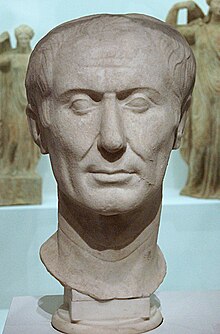Tusculum portrait

The Tusculum portrait, also called the Tusculum bust, is the only extant portrait of Julius Caesar which may have been made during his lifetime.[1] It is also one of the two accepted portraits of Caesar (alongside the Chiaramonti Caesar) which were made before the beginning of the Roman Empire.[2] Being one of the copies of the bronze original,[3] the bust has been dated to 50–40 BC and is housed in the permanent collection of the Museum of Antiquities in Turin, Italy.[4] Made of fine-grained marble, the bust measures 33 cm (1ft 1in) in height.
Description
The portrait's facial features are consistent with those found on coins struck shortly before
In modern day
The Tusculum portrait was excavated by Lucien Bonaparte at the forum in Tusculum in 1825 and was later brought to Castello d'Aglie, though it was not recognised as a bust of Caesar until Maurizio Borda identified it in 1940. The portrait was exhibited in the Louvre alongside the Arles bust. There are three known copies of the Tusculum portrait, which reside in Woburn Abbey and in private collections in Florence and Rome.[4][9]
See also
- Arles bust, possible third lifelike Caesar portrait.
References
- ISBN 978-1317597537.
- ^ ISBN 0892360712.
- ^ ISBN 978-1444308457.
- ^ ].
- ISBN 9780691222363.
- ^ "A New Honour: The Image of Caesar on Coins". Macquarie University. Macquarie University. 10 November 2014. Retrieved 26 January 2021.
- JSTOR 4166364.
- JSTOR 641005.
- ISBN 978-1-4443-0845-7.
